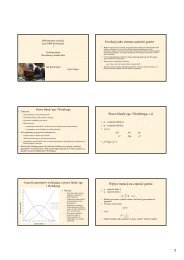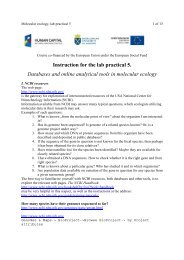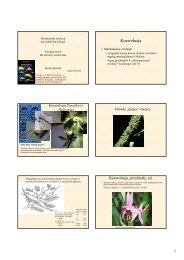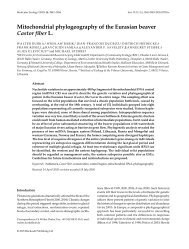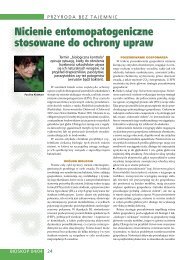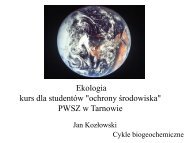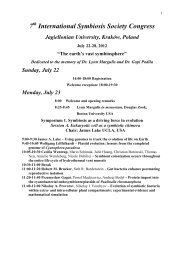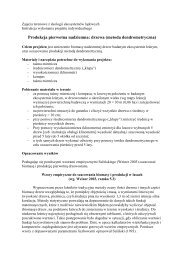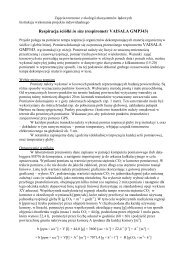Introduction to tropical ecology
Introduction to tropical ecology
Introduction to tropical ecology
You also want an ePaper? Increase the reach of your titles
YUMPU automatically turns print PDFs into web optimized ePapers that Google loves.
Tropical <strong>ecology</strong><br />
WBNZ-849<br />
Ryszard Laskowski<br />
Institute of Environmental Sciences, Jagiellonian University<br />
www.eko.uj.edu.pl/laskowski<br />
1. About the course<br />
2. Lecture #1: <strong>Introduction</strong> <strong>to</strong> <strong>tropical</strong> <strong>ecology</strong>
2/61<br />
Course organization<br />
Place: Institute of Environmental Sciences;<br />
Room 1.1.1<br />
Time: Friday, 14:00 – 17:00 (15 L + 15 S)<br />
9 x 3 h (lectures & conversations)<br />
1 seminar (3 h)<br />
Teachers: R. Laskowski, J. Weiner,<br />
T. Pyrcz, P. Koteja, W. Fiałkowski<br />
Evaluation:<br />
final exam (5-6 6 open questions): 80%<br />
active participation in classes: 20%
3/61<br />
Teachers’ emails<br />
ryszard.laskowski@uj.edu.pl<br />
january.weiner@uj.edu.pl<br />
<strong>to</strong>masz.pyrcz@uj.edu.pl<br />
pawel.koteja@uj.edu.pl<br />
wojciech.fialkowski@uj.edu.pl
4/61<br />
Articles and<br />
textbooks<br />
available at the<br />
course website<br />
Reading<br />
Books from the Library of<br />
Natural Sciences!
5/61<br />
Supplementary reading in Polish
6/61<br />
ATTENTION: The ‘Tropical Ecology’ course (WBNZ 849) is the<br />
prerequisite for ‘Tropical Ecology – Field Course’ (WBNZ 850)<br />
Syllabus: <strong>Introduction</strong> <strong>to</strong> <strong>tropical</strong> <strong>ecology</strong>: <strong>tropical</strong> biomes –<br />
geographical distribution and characteristics; destruction and<br />
protection of <strong>tropical</strong> ecosystems. Equa<strong>to</strong>rial rainforests – the most<br />
diverse biome on Earth. Geographical distribution patterns of<br />
insects in <strong>tropical</strong> mountains. Mimicry. Termites and ants – the two<br />
groups of special importance in <strong>tropical</strong> ecosystems; prey-preda<strong>to</strong>r<br />
preda<strong>to</strong>r<br />
interactions. Adaptations in animals <strong>to</strong> hot<br />
deserts: water balance,<br />
behavioral and physiological mechanisms for obtaining and saving<br />
water; behavioral and physiological thermoregulation; life his<strong>to</strong>ries.<br />
Biology of coral reefs and mangroves: environmental conditions<br />
and biodiversity.
<strong>Introduction</strong><br />
<strong>to</strong> <strong>tropical</strong> <strong>ecology</strong>
8/61<br />
Where are tropics?<br />
Origin of the term: from Greek τρόπος<br />
(tropos) = turn (the sun appears <strong>to</strong> "turn<br />
back" at the solstices)<br />
Area between the Tropic of Cancer<br />
(23 o 30’N) and the Tropic of Capricorn<br />
(23 o 30’S)<br />
Area of the Earth where the Sun is 90 o<br />
above the horizon at least once every year<br />
= <strong>tropical</strong> zone = <strong>to</strong>rrid zone
9/61<br />
Where are the tropics located?<br />
The simplest possible answer:<br />
Area between the Tropic of Cancer<br />
and the Tropic of Capricorn
10/61<br />
Why should we study<br />
<strong>tropical</strong> <strong>ecology</strong>?<br />
Species richness on Earth (per ca. 9274 km 2 ≈ 1° ₓ 1°)<br />
Grenyer, R. et al. 2006. Global distribution and conservation of rare and threatened<br />
vertebrates. Nature 444: 93-96. (pdf available for course participants at the course web page)
11/61<br />
Species richness in tropics<br />
Taxonomic<br />
group<br />
vascular plants<br />
mammals<br />
birds<br />
reptiles<br />
amphibians<br />
Poland<br />
(312 km 2 )<br />
2700<br />
109<br />
446<br />
9<br />
18<br />
Uganda<br />
(241 km 2 )<br />
4900<br />
330<br />
1061<br />
165<br />
52<br />
Sources: Wikipedia; http://www.africapedia.com; EarthTrends<br />
(http://www.vub.ac.be/klimos<strong>to</strong>olkit/sites/default/files/documents/uganda_bd.pdf)
12/61<br />
Biodiversity hotspots on Earth<br />
„As many as 44% of all species of vascular plants and 35% of all<br />
species in four vertebrate groups are confined <strong>to</strong> 25 hotspots<br />
comprising only 1.4% of the land surface of the Earth.”<br />
Myers, N. et al. 2000. Biodiversity hotspots for conservation priorities. Nature<br />
403: 853-858. (pdf available for course participants at the course web page)
13/61<br />
Tropical climates<br />
according <strong>to</strong> Wladimir Köppen
14/61<br />
Tropical climates according <strong>to</strong> Köppen<br />
Group A: Tropical (megathermal(<br />
megathermal) ) climates<br />
Af: Tropical rainforest climate<br />
(~ 5 - 10 o of the equa<strong>to</strong>r; in coastal areas can<br />
extend <strong>to</strong> 25 o ; no seasonality) =<br />
hygromegathermal<br />
Am: Tropical monsoon climate (further from the<br />
equa<strong>to</strong>r; two seasons – rain and dry)<br />
Aw: Tropical savanna climate (two seasons, wet<br />
and dry – very clear and pronounced)<br />
Group B: Dry climates (arid and semiarid)<br />
Only partly belong <strong>to</strong> tropics
15/61<br />
1. Tropical rainforests<br />
Climatic diagram for Belem (Brazil)
16/61<br />
Tropical rainforests: geographical distribution<br />
around equa<strong>to</strong>r (ca. 10 o S – 10 o N)<br />
10 o N<br />
10 o S
17/61<br />
Tropical rainforests: characteristics<br />
Very high annual rainfall: at least 1700 – 2000 mm<br />
Average annual temperature: 27 – 30 o C<br />
High rate of biogeochemical cycles<br />
Soils: low in organic matter and nutrients due <strong>to</strong><br />
intensive weathering (laterization(<br />
oxisols)<br />
Four-layer forests: : (1)(<br />
) emergent layer – single trees<br />
above the canopy (60-70 m); (2)(<br />
) canopy layer (30-45 m);<br />
(3)) unders<strong>to</strong>ry layer (only ca. 5% of light!); (4)(<br />
) forest floor<br />
(only ca. 2% of light)<br />
Richness of epiphytes and lianas<br />
Extreme species richness: approx. 2/3 of all plant and<br />
animal species living on Earth (at only 6% of Earth<br />
surface!)
18/61<br />
Tropical rainforests: types<br />
Lowland equa<strong>to</strong>rial evergreen rainforests<br />
annual precipitation above 2000 mm<br />
Amazon, Orinoco and Congo basins, Indonesia, New Guinea<br />
Wet broadleaf forests partly evergreen<br />
high annual rainfall, warm and wet summer and cooler and<br />
dryer winter<br />
Central America, Caribbean, West Africa, India, Indochina<br />
Montane cloud forests<br />
cooler mountain climate, high rainfall, low cloud cover<br />
<strong>tropical</strong> and sub<strong>tropical</strong> mountains<br />
Floodplain forests<br />
environmental conditions similar <strong>to</strong> lowland evergreen forests<br />
but in poorly drained areas flooding<br />
Borneo, Sumatra, Malay Peninsula, Indochina
19/61<br />
Nutrient turnover rate<br />
Average retention time of dead organic matter and nutrients in forest litter:<br />
boreal forest (taiga), temperate broadleaf forest, and equa<strong>to</strong>rial rainforest<br />
(time in years)<br />
Biome<br />
Organic<br />
matter<br />
N<br />
P<br />
K<br />
Ca<br />
Mg<br />
Taiga<br />
353<br />
230<br />
324<br />
94<br />
149<br />
455<br />
Temperate<br />
forest<br />
4<br />
5.5<br />
5.8<br />
1.3<br />
3.0<br />
3.4<br />
Rainforest<br />
0.4<br />
2<br />
1.6<br />
0.7<br />
1.5<br />
1.1<br />
Schlesinger 1991
20/61<br />
Productivity and carbon accumulation<br />
Average NPP of selected biomes (kg x m -2 x year -1 ),<br />
carbon accumulation rate (g x m -2 x year -1 ) and C(biomass)/C(soil)<br />
Biome<br />
Productivity<br />
C accumulation<br />
rate<br />
C(b)/C(<br />
C(s)<br />
Taiga<br />
0.8<br />
11.7 – 15.3<br />
0.55<br />
Temperate<br />
forest<br />
1.2<br />
0.7 – 5.1<br />
1.13<br />
Rainforest<br />
2.2<br />
2.3 – 2.5<br />
1.68<br />
Lieth & Whittaker 1975, Schlesinger 1991
21/61<br />
Main carbon pools in primeval<br />
<strong>tropical</strong> rainforests<br />
Part of the ecosystem<br />
Alive plants (above and<br />
underground)<br />
Dead trees and litter<br />
Accumulated carbon<br />
(t C/ha)<br />
210<br />
10<br />
Soil<br />
100<br />
TOTAL:<br />
320<br />
After Jonathan Adams, Oak Ridge National Labora<strong>to</strong>ry, TN 37831, USA
22/61<br />
Tropical rainforest soils
23/61<br />
Ferrasols (FAO) = Oxisols (USDA):<br />
location and pedogenesis<br />
Earlier called laterites; ; acc. <strong>to</strong> FAO - ferrasols<br />
Definition: soils containing in the whole profile<br />
≤10% leachable materials and
24/61<br />
Laterization<br />
H + H + H +<br />
AlO x FeO x<br />
FeO<br />
Ca ++ x<br />
SiO 2<br />
Mg ++ Na + K +<br />
SiO AlO<br />
FeO 2 x<br />
x
25/61<br />
Ferrasols (Oxisols) – Kenya
26/61<br />
Laterization – consequences:<br />
Leaching of virtually all organic matter and<br />
nutrients<br />
soils very poor in nutrients<br />
very small reservoirs of soil organic matter<br />
plants have <strong>to</strong> use (re-cycle) all minerals<br />
released from decomposing litter very<br />
efficiently<br />
no nutrient supply after forest destruction and<br />
removal of plants soils become infertile very<br />
quickly difficult forest regeneration<br />
primeval forests replaced with secondary<br />
ecosystems (secondary forests of bushes)
27/61<br />
Four-layer forest structure<br />
Emergent layer:<br />
60-70 m high broadleaf trees<br />
birds, monkeys, bats, butterflies<br />
Canopy layer<br />
30-45 m high, very dense layer<br />
<strong>to</strong>ucans, snakes, treefrogs, , beetles<br />
Unders<strong>to</strong>ry layer<br />
3-44 m high, little sunshine<br />
treefrogs, , beetles, leopards/jaguars<br />
Forest floor<br />
very dark few plants<br />
anteaters, snakes, frogs, beetles<br />
http://www.srl.caltech.edu/personnel/krubal/rainforest/Edit560s6/www/whlayers.html
28/61<br />
Four-layer<br />
forest structure
29/61<br />
Diversity of life forms: epiphytes and vines
30/61<br />
Extreme species richness
31/61<br />
Species richness<br />
of <strong>tropical</strong> rainforests<br />
At 10 ha of forest in Borneo – up <strong>to</strong> 700 tree<br />
species as many as in whole N. America!<br />
At 1 Peruvian tree – 43 ant species as<br />
many as in whole UK!<br />
Ca. 3000 fish species in the Amazon river –<br />
more than in whole North Atlantic ocean!<br />
Species numbers at 15 km 2 in Costa Rica:<br />
mammals – 117 (in whole Poland 105); ; birds –<br />
410 (435);; reptiles – 86 (9);; amphibians – 43<br />
(18);; moths – 4000 (1200);; vascular plants –<br />
1668 (2700)
32/61<br />
Tropical rainforests:<br />
montane cloud forests (fog forest)<br />
Specific type of <strong>tropical</strong> rainforests:<br />
area: <strong>tropical</strong> mountains<br />
environmental conditions: persistent or<br />
frequent low-level level cloud cover and fog <br />
reduction of direct radiation and<br />
evapotranspiration, very high humidity<br />
ecosystem characteristics: particularly<br />
rich in epiphytes (mosses, ferns, orchids,<br />
etc.)
33/61<br />
Montane cloud forests
34/61<br />
2. Tropical and sub<strong>tropical</strong> seasonal dry<br />
broadleaf forests (monsoon forests)<br />
Climatic diagram for Calcutta (India)
35/61<br />
Monsoon forests: geographical distribution<br />
Two belts N and S from equa<strong>to</strong>rial<br />
rainforests: ca. 10 o – 20 o N & 10 o – 20 o S
36/61<br />
Monsoon forests: characteristics<br />
High average annual temperature<br />
High annual rainfall (~1000(<br />
– 2000 mm/year)<br />
Clearly pronounced, long (few months) dry season<br />
most trees shed leaves in dry season;<br />
plants accumulating water;<br />
rich unders<strong>to</strong>ry layer (plenty of sunlight in dry season)<br />
three layers: : (1)(<br />
) tree canopy; (2)(<br />
) unders<strong>to</strong>ry; (3)(<br />
forest<br />
floor
37/61<br />
Main carbon pools<br />
in monsoon forests<br />
Ecosystem part<br />
Alive plants (above- and<br />
underground)<br />
Dead trees and litter<br />
Accumulated carbon<br />
(t C/ha)<br />
150<br />
10<br />
Soil<br />
100<br />
TOTAL:<br />
260<br />
After Jonathan Adams, Oak Ridge National Labora<strong>to</strong>ry, TN 37831, USA
38/61<br />
Monsoon forest in dry season<br />
Monsoon forest in Trinidad
39/61<br />
Monsoon forests: characteristic<br />
tree species<br />
Teak tree<br />
(Tec<strong>to</strong>na sp.)<br />
Ebony tree (Diospyros sp.)
40/61<br />
Tropical grasslands<br />
Climatic diagram for Nairobi (Kenya)
41/61<br />
Tropical grasslands in the world<br />
Africa:<br />
Savannah, , e.g. Serengeti, Masai Mara – high grasses<br />
with scattered acacia trees; large herbivores (40<br />
ungulate species) and carnivores<br />
South America:<br />
Llanos in Venezuela (Orinoco basin) – flooded every<br />
year, with gallery forests<br />
Cerrado in Brazil – grassland covered with forest of<br />
different density and gallery forests; high plant diversity<br />
Australia:<br />
Savannah (Northern Australia) – grassland with<br />
scattered eucalyptus trees; herbivores – kangaroos and<br />
man-introduced ungulates
42/61<br />
Savannah<br />
Average annual precipitation 1000-1500 1500 mm<br />
(Köppen’s Aw climate)<br />
Distinct, long dry season;<br />
Temperature: 20-30<br />
o C<br />
NPP: ca. 0.70<br />
7 kg m -2 year -1<br />
Plants – adaptations<br />
<strong>to</strong> dry season: deep tap roots, thick bark,<br />
shedding leaves, s<strong>to</strong>rage organs (mostly<br />
underground)<br />
<strong>to</strong> herbivores: solid sharp leaves, bitter taste,<br />
growing from beneath)
43/61<br />
Savannah soils<br />
O<br />
A/B<br />
Lateritic<br />
layer<br />
Mixed A and<br />
B layers<br />
Silica<br />
leaching silica (SiO 2<br />
)<br />
during rain season<br />
thickness<br />
1-2 m<br />
C<br />
Weathering<br />
Bedrock<br />
capillary uptake from<br />
ground water during<br />
dry season
44/61<br />
Tropical grasslands
45/61<br />
Main carbon pools<br />
in <strong>tropical</strong> savannah<br />
Ecosystem part<br />
Alive plants (above- and<br />
underground)<br />
Dead trees and litter<br />
Accumulated carbon<br />
(t C/ha)<br />
35<br />
0<br />
Soil<br />
55<br />
TOTAL:<br />
90<br />
After Jonathan Adams, Oak Ridge National Labora<strong>to</strong>ry, TN 37831, USA
46/61<br />
Main carbon pools in <strong>tropical</strong> grasslands<br />
besides savannah<br />
Ecosystem part<br />
Alive plants (above- and<br />
underground)<br />
Dead trees and litter<br />
Accumulated carbon<br />
(t C/ha)<br />
12<br />
0<br />
Soil<br />
42<br />
TOTAL:<br />
54<br />
After Jonathan Adams, Oak Ridge National Labora<strong>to</strong>ry, TN 37831, USA
47/61<br />
Tropical deserts<br />
Climatic diagram for Cairo (Egypt)
48/61<br />
Desert soils – aridisols (USDA)<br />
(FAO: gypsisols, calcisols, solonchaks, solonetzes)<br />
Desert soil profile: clearly<br />
seen calcareous layer<br />
Main process: CaCO 3 and MgCO 3<br />
accumulation development of<br />
calcareous layer<br />
rain + atmospheric CO 2 weak carbonic<br />
acid<br />
dissolving Ca and Mg salts from surface<br />
minerals<br />
transport <strong>to</strong> deeper soil layers<br />
evaporation increasing concentration<br />
of dissolved minerals<br />
solidification of salts from the solution<br />
concentrations of salts <strong>to</strong>xic <strong>to</strong><br />
plants and animals<br />
water-impermeable carbonate<br />
layer
49/61<br />
Main carbon pools<br />
in <strong>tropical</strong> deserts<br />
Ecosystem part<br />
Alive plants (above- and<br />
underground)<br />
Dead plants and litter<br />
Accumulated carbon<br />
(t C/ha)<br />
1<br />
0<br />
Soil<br />
0<br />
TOTAL:<br />
1<br />
After Jonathan Adams, Oak Ridge National Labora<strong>to</strong>ry, TN 37831, USA
50/61<br />
Mountains change everything<br />
Elevation (m.a.s.l.)<br />
Latitude
51/61<br />
Mountains change everything:<br />
correlation between horizontal and<br />
vertical distribution of plants<br />
J. Kornaś and A. Medwecka-Kornaś – Geografia roślin (2002)
52/61<br />
Vertical distribution of plants in African<br />
and South American mountains<br />
J. Kornaś and A. Medwecka-Kornaś – Geografia roślin (2002)
53/61<br />
Species richness decreases<br />
with altitude<br />
Relationship between the number of species and altitude:<br />
bats in Manu Biosphere Reserves (Peru)<br />
Gas<strong>to</strong>n, K. J. 2000. Global patterns in biodiversity. Nature 405: 220-227.
54/61<br />
Ecofloristic zones in mountains<br />
Alpine: ~3800 – ~4500 m<br />
high mountain steppe: Afro-alpine<br />
alpine, paramo, puna<br />
Subalpine: ~3400 – 3800 m<br />
few lianas and vascular epiphytes, rich moss and lichen<br />
flora; characteristic groups: Ericaceae, Brunelliaceae,<br />
Asteraceae...<br />
‘elf forests’ at ridges<br />
Montane: ~2400 – 3400 m<br />
short trees, even fewer species; few lianas, still many<br />
epiphytes; can be seasonal<br />
Submontane: ~1000 – 2400 m<br />
forest similar <strong>to</strong> that at lower elevation but with fewer<br />
species; trees ca. 25-30 m
55/61<br />
Tropical mountain<br />
zones in AndesA<br />
ndes:<br />
Venezuela<br />
„Tierra fria”<br />
Paramo<br />
„Tierra fria”<br />
Upper montane<br />
forest<br />
„Tierra templada”<br />
Lower montane forest
56/61<br />
Tropical mountain<br />
zones in Africa:<br />
Kilimanjaro<br />
Alpine<br />
Montane<br />
Submontane
57/61<br />
Other <strong>tropical</strong> plant communities<br />
Mangroves<br />
areas: shallow, muddy sea coasts;<br />
structure: trees or shrubs, very few or even just<br />
one species; no unders<strong>to</strong>ry and forest floor; few<br />
epiphytes and lianas<br />
Gallery forests<br />
areas: along valleys with surface or<br />
underground streams<br />
structure: trees or bushes of different density;<br />
possible lianas, few epiphytes
58/61<br />
Mangroves<br />
Caribbean coast,<br />
Venezuela
59/61<br />
Gallery forests<br />
Gran Sabana, Venezuela
60/61<br />
Gallery forests<br />
Gran Sabana,<br />
Venezuela
61/61<br />
Topics for the seminar:<br />
1)Tropical diseases: most important diseases,<br />
prevention & problems<br />
2) Is it possible <strong>to</strong> res<strong>to</strong>re destroyed <strong>tropical</strong><br />
rainforests? Área de Conservación Guanacaste –<br />
a case study in Costa Rica.<br />
3) ...?<br />
...



